Apparently, while a certain infamous secret agent was screwing around with his latest gold-themed nemesis, disrupting a poolside high-stakes (and totally rigged) game of gin rummy at the Fontainebleau Hotel by compromising the villain’s card-counting spy (-- and later getting her killed for this betrayal rather gruesomely with a suffocating coat of paint), further down the pool, trashy pulp-novelist Tom Harris was concurrently holding court over a sizeable knot of bikini-clad vixens; all totally engrossed and quite aroused as he gives a very dynamic oration of his most purplest of prose.
Editors Note: None of this actually happened, of course; it’s just both the James Bond vehicle, Goldfinger (1964), and today’s film shot at the same Miami Beach resort around the same time, and this mere coincidence was as close to a shared universe as these franchises would never get. Moving on...
But just as Harris (Joyce) gets a certain playmate so intoxicated on his salacious innuendo she essentially starts dry-humping his leg (-- which I’m guessing passes as foreplay for this guy), he’s suddenly cock-blocked by the arrival of his literary agent, Duncan Fairchild (Stapleton), who reminds him they have urgent business to attend to elsewhere. At first, Harris tries to blow this off until what turns out to be his latest groupie’s husband storms the pool area, ready to righteously cave the man’s head in for canoodling with his wife -- an encounter Harris barely survives with all his parts intact thanks to Fairchild and his waiting getaway vehicle.
Now, the reason for this ersatz rescue is Harris owes Fairchild another book sale that is critically overdue. And knowing Harris like he does, meaning he hasn’t even put pen to paper yet, to help speed up the process, it seems Fairchild has stumbled upon some fortuitous inspiration while playing cards with a certain English nobleman (-- no, not the one mentioned earlier), who revealed he’d just inherited a remote island somewhere in the Caribbean, where the natives practice Voodoo when they’re not avoiding the myriad poisonous snakes reputed to reside there -- and don’t discount all those rumors, which say said island is also inundated with an army of zombies either. But don’t worry, says Fairchild, they won’t have to rough it too hard, since there is also a reclusive scientist holed up on the island, who’s established a home and lab to try and find a cure for cancer based on the herbs the natives use in their black magic rituals mixed with all the readily available snake venom.
But it isn’t until Fairchild mentions how a recent hurricane wiped out the entire native fishing fleet, leaving five women for every man left on the island before a reluctant Harris trips over his own wagging tongue and finally signs on. Hence, Voodoo Island sounds like perfect brain-fodder for one of Harris’ lurid pulps, and it’s also the perfect vacation spot for Fairchild’s highly eccentric wife, Coral (Linton), which is why she is impatiently waiting for them at the airport. Then, this really not-well-thought-out expedition (-- I mean, does the doctor even know they’re coming? --) hits its first of many snags when the exact location of Voodoo Island proves stubbornly elusive. Luckily, with the plane running on fumes, land is finally spotted and Harris takes over to make a dead-stick landing on the beach.
Telling the others to remain with the plane, Harris heads off into the jungle to try and reach the large hacienda he spotted on the way down and bring back some help. Aside from a few of those mentioned snakes, Harris also finds a beautiful girl skinny-dipping in a tidal lagoon, calls out to her, but she doesn’t hear him. And then, as he tries to get closer, Harris spots what will pass for a zombie in this movie:
A tall, gaunt native, skin the color of clay, its eyes apparently pasted over with dried oatmeal, who is also spying on the girl, machete in hand, its intention of menace perfectly clear. The girl finally hears Harris’s warnings, sees the danger, makes it to shore and disappears into the jungle.
Her would be rescuer then manages to intercept the zombie, derailing its pursuit, but discovers his gun has no effect on the creature -- hard to kill something that’s already dead, ‘natch, and then nearly gets cleaved in half for his troubles. Thus, full naked retreat is the order of the day. And as he barely stays one step ahead of his ghoulish pursuer, Harris stumbles upon a healthy native, who offers to take him to the apparent safety of the doctor’s compound. But once the superstitious fisherman takes a huge plot dump, saying how the local Voodoo sect plans to make a human sacrifice that very night to appease their high priest, Papa Neybo, the zombie pounces and decapitates him with the machete -- and soon has Harris pinned against a tree, ready to relieve our hero of his head, too...
While Richard Cunha and Del Tenney will always be two of my favorite purveyors of regional schlock cinema, with Cunha tapping into the zeitgeist of those old men’s adventure and sweat magazines, and then followed this string to it’s logical conclusion with the Nazisploitation classic, She-Demons (1958), and Tenney pushing boundaries with seedy and seamy titillation and sexual shocks with Violent Midnight (1963) and adding bursts of gore in Curse of the Living Corpse (1964) and the totally gonzorrific, The Horror of Party Beach (1964), they seem to remain unjustly unheralded by everyone else. This boggles my brain since both men tapped into something unseemly in the late 1950s and early ‘60s, delivering independently what the mainstream studios just couldn’t get past the censors. Cheap and tawdry on the surface, but nasty and startlingly effective underneath. And sadly, both men’s exploitation movie careers would prove all too short.
So, what happened? Well, I go more into Cunha’s history and brief output in my review of She-Demons, and Tenney’s career got dissected in earlier reviews of both Violent Midnight and The Horror of Party Beach, but I barely scratched what happened after Tenney and his producer, Alan V. Iselin, managed a national and highly profitable release for their whackadoodle regional double-bill through 20th Century Fox. Seems Fox was so pleased with the box-office results they apparently wanted a follow-up: Frankenstein Meets the Space Monster and Voodoo Bloodbath. Iselin would serve as producer for the first film, while Tenney would write, produce, and direct the bottom bill all by himself.
Leaving the friendly confines of Stamford, Connecticut, where he had shot his first three features with a crew and casts culled from his old theater buddies, Tenney headed to south Florida and Key Biscayne, which was mostly jungle swamps back in 1964. With a budget of $120,000, which equaled the budgets of his first three features combined, Tenney was forced to abandon his usual pals and work with a union crew as dictated by Fox. Most of this production crew were locals, cobbled together by Bill Grefe, a burgeoning member of Florida’s own exploitation film boom, who would go on to produce and direct things like Death Curse of Tartu (1966), Sting of Death (1966), and Jaws of Death (1976) -- sensing a pattern there; and Grefe proved so invaluable he earned himself an assistant director’s credit on Tenney’s film.
Shooting under the friendlier title of Caribbean Adventure, according to later interviews with Tenney the whole experience was rather miserable. The teamsters were “slow and uncooperative,” there were sharks stranded in a needed lagoon -- Tenney shot anyway and failed to inform his actors between takes, and a passing hurricane didn’t help either. Scheduled and budgeted for two weeks, filming lasted for nearly three as on top of the inclement weather, both cast and crew fell victim to swamp fever and snakebites, causing even more delays.
Once filming finally wrapped, Tenney took the footage back to Connecticut, spliced it together, and didn’t like what he saw at all. Fox wasn’t all that impressed either as the distribution deal quickly fell apart. And while Frankenstein Meets the Space Monster (1965) eventually found a home at Allied Artists, paired up with a repurposed British import, Curse of the Voodoo (1965), Voodoo Bloodbath wound up on a shelf, unseen, for over six years until Jerry Gross unearthed it in 1971, paying Tenney $40,000 so he could pair it up with David Durston’s I Drink Your Blood (1971), rechristening it as the nonsensical I Eat Your Skin (1971) by Cinemation’s crack publicity team, who unleashed both in a legendary “Two Great Blood-Horrors to Rip-Out Your Guts!” drive-in double feature.
Thus and so, audiences were finally able to see what Tenney had concocted; a bizarre mash-up of a Donald Westlake novel by way of Jacques Tourneur’s I Walked with a Zombie (1943), and these disparate elements were then hammered into what was, essentially, a sober remake of Zombies Over Broadway (1945), which wasn’t that great of a movie to begin with (--sorry, Bela,) as Harris’s head is saved at the last moment by the timely arrival of Charles Bentley and his jeep filled with a heavily armed flying squad, who frighten the zombie off.
Harris then introduces himself as a guest of Lord Carrington, who just inherited the island, remember, of which Bentley (McCoy) apparently oversees for the absent heir. Strangely, given the obvious evidence, Bentley denies it was a zombie who attacked a grateful Harris, claiming the simple natives can’t comprehend one of their own going homicidally insane, saying the one who attacked him had recently killed his entire family but has remained stubbornly elusive as he tries to capture him. Thus, zombies, he concludes to a dubious Harris, do not exist and are mere wishful thinking by writer's like him and the island’s voodoo sect. Meantime, back at the beach, Bentley and Harris arrive just in time to save the others from an angry mob of living islanders, who are quickly quelled by Bentley as he orders them to secure and refuel the plane while he takes his master’s guests to the main house, where they recover from their harrowing day.
That evening, as the Fairchilds squabble while trying to enjoy the tropical sunset, Harris keeps abandoning his typewriter to go poke around, asking one of the housekeepers (Oliver) about the constant chorus of ominous drums emanating from the jungle, and if she knows anything about a scheduled human sacrifice later that night. And while she feigns ignorance, I’m betting she does, since we’ve already met her in the film’s opening coda, where she was an active participant in a wild and frenetic voodoo ritual, which ended with a goat and an enthralled woman on the sacrificial altar for Papa Neybo, but we cut away before seeing which one of them lost their heads.
When the dinner bell rings, Harris bumps into the woman he saw swimming earlier, Janine Biladeau (Hewitt), and then meets her father, Dr. Augustus Biladeau (Stanton), the man looking for the cure, as they gather at the table. Here, Harris recounts his zombie encounter and asks Dr. Biladeau about the wild rumors about an army of the walking dead lurking on this island. Biladeau quickly writes this off as native superstition. However, unlike Bentley, he doesn’t deny the existence of “zombies” only they’re not what Harris thinks, explaining how the voodoo cult uses a plant based narcotic that makes people resemble a brain-dead automata and makes them highly susceptible to suggestion or, in some cases, it has been known to drive the victims mad.
After dinner, pressing Bentley for more info on the voodoo cult, Harris is told an old fable about the island where the chieftain's son made a full recovery from a mystery malady after sacrificing a fair-haired virgin. Ergo, Papa Neybo and his brood believe blonde virgins make the best human sacrifices. And while that sounds like Biladeau's daughter is prime sacrificial material to Harris, Bentley once more scoffs, leaving it up to the author to get Janine off the island or, uh ... “deflower her” -- in a biblical sense before it's too late. And while Janine seems hot to trot on that front, Harris decides to stick with Plan A -- especially when he and Janine are ambushed while out on a moonlit walk, and the girl is nearly carried off to a certain doom before Harris manages to get her away and back to the compound, meaning no sacrifice tonight.
The next morning, despite the imminent danger, Janine won’t leave the island without her father, who has given his blessing for her immediate departure with the others but refuses to go, too, claiming he is close to a breakthrough -- though from what we’ve seen in his secret lab, I believe Bilideau is hiding the real truth.
For, it turns out, his experiments with irradiated snake venom is what’s really causing the zombie mutations, as his injected test-subjects transform into more of those pasty, dried-oatmeal faced ghouls, and I’m thinking he’s got something a little madder on his mind that will in no way benefit mankind.
Well, turns out Harris and Janine secretly witnessed this latest zombie conversion, and then find a cabin completely full of zombies silently waiting for orders as they try to flee when caught snooping around, meaning the rumors of that undead army were true all along.
Escaping to the beach, where the others are waiting to leave, Harris, Fairchild, and the pilot start pushing the plane onto their makeshift runway. Alas, while they were occupied, a swarm of zombies snatch Janine and Coral. And as the pilot starts the plane, he spies a zombie slowly stumping toward him, in his arms a crate of explosives.
And then, in the film’s most effective scene, the zombie walks right into the spinning prop, which detonates the explosives, killing the pilot and destroying their means of escape. More zombies come, and chase the remaining two men off a cliff and into the water below.
But Harris and Fairchild not only survive the fall, they find a yacht and commandeer it. Hearing the voodoo drums kicking up again, to save the girls, the two men don ritual masks and serapes to infiltrate the voodoo hootenanny just in time to save Janine from being beheaded by Papa Neybo. Well, technically, Dr. Biladeau saved her from the shadows when the knife he throws strikes Papa Neybo down, which reveals -- *gasp* -- he was really Bentley all along!
Yeah, seeing that Biladeau’s horrific experiments were going nowhere fast, seems Bentley decided to cash-in on the detrimental side-effects and was blackmailing the scientist with the life of his daughter in the balance into creating an unstoppable army of zombies so he could conquer the world. But now his plan lies in ruin as the interlopers escape through Biladeau’s lab, where the scientist overloads his equipment, which leads to a chain-reaction that nukes Voodoo Island off the map as our heroes speed away to safety.
Okay, well, turns out Tenney was right all along: Voodoo Bloodbath / I Eat Your Skin was indeed a pretty terrible film. It reminds me a bit of George Romero and his zombie films post Night of the Living Dead (1968). Sure, the rest of Image 10 gang needed Romero a helluva lot more than he needed them but, to me, his subsequent films were always missing a certain … somthin’ somethin’ that Night of the Living Dead had. And I think the same goes for Tenney once he got out of his Connecticut comfort zone.
I mentioned in my review of Violent Midnight how one of Tenney’s cinematic strengths was how efficiently he spent his minuscule budgets, forcing a lot of outside the box creativity, and how every last dime wound up on screen. And there’s bits and pieces of that same Tenney magic in Voodoo Bloodbath / I Eat Your Skin as I think there’s a fairly serviceable zombie flick in there, somewhere, that got lost in the extraneous dreck.
The voodoo rituals themselves are kind of amazing, staged and executed well, and really show off Tenney’s theatrical roots. And the fact the islanders speak Spanish that goes completely untranslated instead of the usual broken English gives a real flare of authenticity. But then these same sequences get short-circuited a bit when Lon Norman’s Hoyt Curtin-inspired spazz-jazz score once more asserts itself with all the subtlety of a game of whack-a-mole.
Also in the failure column we have the odious comedy relief of Dan Stapleton and Betty Hyatt Linton, who were trying to be K-Mart knock-offs of Mike Nichols and Elaine May but missed the boat by a nautical mile. Not helping matters was a horrific dub-job for Linton, with the uncredited actress really laying into those nasally tones. And the most confusing thing is, I am almost positive that was Linton’s real voice used during the dinner scene and, well, she sounded fine to me. William Joyce is serviceable enough as the square-jaw, though his character is a bit of a smarmy ass, and Heather Hewitt has a nice perkiness as the distressed damsel.
Even the zombies themselves hold some menace as they silently stalk around, relentlessly, overwhelming in numbers, or come at you alone with a machete, but they’re always ultimately betrayed and undone by the lackluster and, at times, totally laughable make-up. And the fact that Robert Verberkmoes was responsible for the design and execution of the zombies, the same guy who gave us those delightfully demented pigeon-toed, knock-kneed, google-eyed, and bratwurst-bogarting atomic fish critters from The Horror of Party Beach, puts the final nail in the coffin and makes the overall failure of Voodoo Bloodbath / I Eat Your Skin sting even worse.
What is Hubrisween? This is Hubrisween! 26 Days! 26 Films! 26 Reviews! And now, Boils and Ghouls, be sure to follow this linkage as The Fiasco Brothers and Yours Truly countdown from A to Z all October long! That's nine reviews down with 17 more to go! Up Next: Atomic Mega-Punching Kaiju Pinatas!
I Eat Your Skin (1964/1971) Iselin-Tenney Productions Inc. :: Cinemation Industries / P: Del Tenney / D: Del Tenney / W: Del Tenney / C: François Farkas / E: Larry Keating / M: Lon E. Norman / S: William Joyce, Heather Hewitt, Betty Hyatt Linton, Dan Stapleton, Walter Coy





































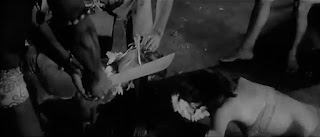













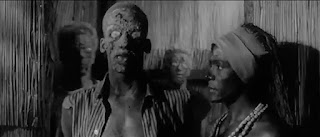








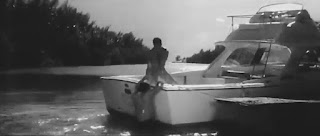







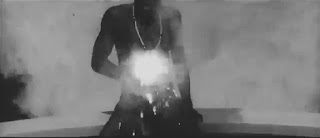







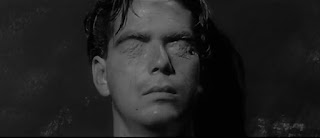




No comments:
Post a Comment